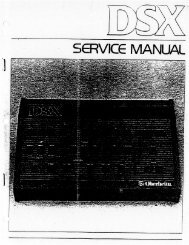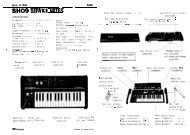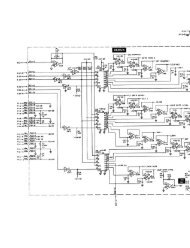ARP2600 - Fundamentals of Music Technology - Cyborgstudio.com
ARP2600 - Fundamentals of Music Technology - Cyborgstudio.com
ARP2600 - Fundamentals of Music Technology - Cyborgstudio.com
Create successful ePaper yourself
Turn your PDF publications into a flip-book with our unique Google optimized e-Paper software.
064 - SECTION EIGHT: THE VCATHE VCA VS. THE VCFOne may recall from Section 6 that by setting the VCF’s Fc all the way closed, one can stop the signalfrom passing through the filter, thus changing the signal’s volume. Isn’t this what the VCA does? Atfirst glance, it might seem so. Actually, as the filter’s Fc is lowered, the actual timbre <strong>of</strong> the sound<strong>com</strong>ing through it will change as well, since harmonics will be removed from the sound and the soundwill be<strong>com</strong>e duller as the Fc gets lower. When using the VCA to change amplitude, the signal <strong>com</strong>ingthrough will have a consistent timbre regardless <strong>of</strong> the volume at which the VCA is outputting thesignal. One can hear the difference between a filter sweep and a VCA sweep by listening to CD track42.HOW DOES ONE USE IT?Like the VCF, sounds input at the audio inputs will emerge from the audio output. Sounds <strong>com</strong>ing intothe VCA actually pass through it and <strong>com</strong>e out the output. The VCA does not actually make any sound.In order to use the VCA, audio signals must be fed into it via one <strong>of</strong> the two audio inputs. The attenuationslider above this input must be raised, or else no sound will be permitted to enter into the VCA.One must take care not to raise the slider too high, however, as distortion can occur. Distortion is a statein which more electrical signal than a circuit can handle is put through a circuit and it will be discussedin Section 12.The INITIAL GAIN must also be set. Under normal circumstances, the INITIAL GAIN slider will beset to closed (full left) as it will then gate the sound and create silence in between the times when notesare being played. When an audio signal is being fed to one <strong>of</strong> the VCA’s audio inputs, moving theINITIAL GAIN slider is like turning the volume knob on a radio. It changes the amplitude <strong>of</strong> the signal<strong>com</strong>ing out.Most <strong>of</strong> the time, it will be desirable to have another module modulating the amplitude <strong>of</strong> the in<strong>com</strong>ingwaveforms on the VCA. One might think <strong>of</strong> this as ‘amplitude modulation,’ and indeed this is a form<strong>of</strong> AM. However, this term will usually be used for another technique which will be explained atanother time. Generally, either an EG or an LFO is used to control the VCA’s amplitude. Carefulobservation will show that one <strong>of</strong> the two EGs is normalled to each <strong>of</strong> the control inputs on the VCA.The VCA’s gain or amplification is the only parameter which can be modulated on the VCA, hence thename ‘voltage controlled amplifier.’USING THE VCA IN PATCHESIf one creates a patch in which there is an audible signal present at the VCA’s audio input, the correspondingattenuation slider is raised, and the initial gain is set fully closed, the VCA will be silent sincethe gain is set fully closed. As more voltage <strong>com</strong>es into the control input, the VCA will allow more andmore in<strong>com</strong>ing signal to pass through to its output.It is interesting to note that the VCA’s gain is reduced from the initial gain setting if the in<strong>com</strong>ingcontrol voltage is negative. For instance, if a sine wave is fed to the control input, the gain will be















